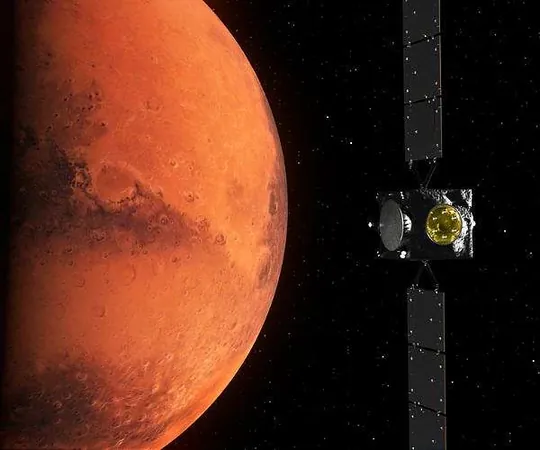
Hera Embarks on Thrilling Journey to Mars with Groundbreaking Deep-Space Burn!
2024-11-09
Author: John Tan
Hera's First Trajectory Correction
In an incredible achievement for space exploration, ESA's Hera mission has successfully completed its first critical trajectory correction since its launch on October 7, 2024. This pivotal adjustment positions Hera for a vital gravity assist from Mars, scheduled for March 2025, which could revolutionize our understanding of the universe.
The Deep-Space Burns
On October 23, Hera's innovative trio of orbital control thrusters executed a remarkable burn lasting 100 minutes, altering its speed by approximately 146 m/s. This impressive display was followed by a secondary burn on November 6, which lasted for 13 minutes and provided an additional velocity boost of 20 m/s, ensuring the spacecraft maintains its correct path towards Mars.
Expert Insights on the Maneuvers
Sylvain Lodiot, the Hera Spacecraft Operations Manager, explained the intricacies of these deep-space maneuvers: "Deep-space manoeuvres are often split into parts. The first, larger burn does most of the work. After precisely measuring the spacecraft's trajectory, we perform a second, smaller burn to correct any inaccuracies."
Seamless Support from ESA's Control Team
The operations were seamlessly supported by ESA's control team at the European Space Operations Centre (ESOC) in Germany. Utilizing deep-space antennas located in Spain, Argentina, and Australia, the team meticulously monitored Hera's velocity changes during both pivotal burns.
Positive Trajectory Analysis
Francesco Castellini from ESOC's Flight Dynamics team provided positive news, stating, "We are now analyzing Hera’s new trajectory following the second burn. It appears to have gone very well. We will execute a much smaller correction maneuver of a few tens of cm/s on November 21 to fine-tune the trajectory for the upcoming Mars flyby."
Harnessing Mars’ Gravity
By harnessing Mars’ gravitational pull, Hera's journey to the Didymos asteroid system will not only shorten its travel time but also conserve precious fuel. Pablo Munoz from ESOC’s Mission Analysis team noted, “We are very fortunate that Mars is in the right place at the right time. This design uses Mars's gravity to boost Hera's speed, allowing it to arrive at Didymos months ahead of schedule.”
Exciting Close Approach to Deimos
Hera’s trajectory alignment also includes a thrilling close approach to Mars' moon, Deimos, presenting a rare scientific opportunity to observe this small celestial body from just 300 kilometers away. This close encounter promises to shed light on Deimos’ composition and history, enhancing our understanding of celestial mechanics and the formation of planetary bodies.
Upcoming Milestones
Looking ahead, Hera's mission is packed with exciting milestones. In February 2026, another deep-space maneuver is planned, followed by rendezvous operations scheduled between October and December 2026 to approach Didymos. Hera aims to investigate outcomes from NASA's DART mission and delve into critical questions regarding binary asteroid systems, including the internal structure of Dimorphos and the crater left by DART's historic impact.
Future Aspirations for Planetary Defense
As ESA continues to push the boundaries of asteroid research, discussions are already underway regarding the future Ramses mission to the infamous Apophis asteroid. Moreover, the Near-Earth Object Coordination Centre is actively engaged in asteroid discovery and monitoring, recently identifying the tenth asteroid likely to impact Earth.
International Workshop on Planetary Defense
Next week, ESA's Planetary Defence Office will host an illuminating workshop at ESOC, bringing together top international experts to improve measurement techniques for potentially hazardous near-Earth asteroids. This event, supported by the European Commission, aims to advance global efforts in planetary defense and ensure a safer future for all.
Stay Tuned!
Stay tuned as we follow Hera on this exhilarating journey—who knows what new cosmic secrets it might unveil!


 Brasil (PT)
Brasil (PT)
 Canada (EN)
Canada (EN)
 Chile (ES)
Chile (ES)
 España (ES)
España (ES)
 France (FR)
France (FR)
 Hong Kong (EN)
Hong Kong (EN)
 Italia (IT)
Italia (IT)
 日本 (JA)
日本 (JA)
 Magyarország (HU)
Magyarország (HU)
 Norge (NO)
Norge (NO)
 Polska (PL)
Polska (PL)
 Schweiz (DE)
Schweiz (DE)
 Singapore (EN)
Singapore (EN)
 Sverige (SV)
Sverige (SV)
 Suomi (FI)
Suomi (FI)
 Türkiye (TR)
Türkiye (TR)